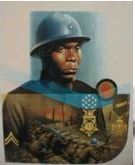Photograph credits: Charles Blatcher (Left) Corporal Freddie Stowers, USA (Center- (Photo Credit: Photo Courtesy of South Carolina Military Museum and Sergeant Henry Johnson, USA(right -web photo)
This year’s Black History Month theme recognizing Blacks in the Military during World War I is most timely. It is recorded that over 400,000 served in the Armed Forces, the Army manned the 92nd and 93rd Divisions. The majority of the Black Soldiers of the era served in the United States Army.
The United States Army questioned their fighting skills. There were no intention on the part of the Army to engage their service in combat. Ninety percent of the Black Soldiers served as depot, stevedore and laborers. However, the French Army was in need of manpower and welcomed the 369th, 370th, 371st and 372nd Infantry Regiments.
The first to see combat was the 369th Infantry Regiment. They arrived in France in 1917 and were put on loan to the French 4th Army. There wore American Uniforms and carried French weapons. The regiment was sent to the front line where they served 191 days of trench warfare. They became known to the Germans as the “Hell Fighters.” They proclaimed themselves the “Black Rattlers.” Six months after their arrival, the 370th, 371st and 372nd Regiments of the 93rd Division arrived in France. The Regiments saw extensive combat while serving with the French Army.
The highest ranking Black Officer in the Armed Forces during the era was the legendary Colonel Charles Young. Until recently he was the focus of our advocacy. We were seeking an honorary Presidential promotion for him to the rank of Brigadier General in the United States Army. We have put that advocacy on hold for the time being. For those unfamiliar with the Colonel’s History, he was the third Black graduate of West Point Military Academy, first Black Military Attaché to a foreign government and first Black Superintendent of a National Park among many other accomplishments in a military career that spanned three decades. He was medically discharged from the United States Army prior to the United States entering the war. Although the Army Review Board recommended his retention on active duty in the capacity of full colonel, the decision to medically discharge him came from the War Department.
Jim Crow was the law of the Land. Black Officers could not command white troops. The military had a dilemma, had the Colonel been given a command as recommended by then General John Pershing, he would have been positioned for advancement to the rank of Brigadier General. Because of his rank there were few places to assign him where he would not out rank many of the White Officers. The medical discharge was a convenient alternative for the Army. To demonstrate his fitness to serve, the Colonel rode a horse from Wilberforce, Ohio to Washington DC. A distance of 497 miles. He was reinstated to active duty five days before the Armistice was signed ending the war. However, he missed the opportunity to lead troops in combat during World War 1.
The National Coalition of Black Veteran Organizations appreciate the National Association for the Study of African American Life and History for designating soldiers of the Era the focus of Black History Month. Black Soldiers, especially of the World War I Era have not been properly recognized in American History. Years ago we made an inquiry to review the military records of Colonel Charles Young. We were informed that his file and the files of other World War I veterans were lost in the fire at the National Personnel Records Center in Saint Louis, Missouri in 1973.
It would have been interesting to see the service files of the Infantry Regiment personnel. What might their files contain beyond basic enlistment information? They served under the command of the French Army. The deeds of valor committed among them went unacknowledged by the United States Army. Therefore it is questionable if the information was committed to their service records. The omission would account for why so few Black Soldiers were recognized by the US Army for action in World War I. However, one would like to believe if the information was available the United States Army would have issued equivalent Medals, Ribbons or Citations to acknowledge the men’s service. Regardless to the Command they were assigned, they were American Soldiers.
France appreciated the service. Black Soldiers were recognized by the French Government. Needham Roberts and Henry Johnson members of the 369th Infantry Regiment were the first American Soldiers to be awarded the French Croix de Guerre Medal for gallantry in combat. By the war’s end the entire Regiment were awarded the prestigious medal. They were the highest decorated Black Soldiers of the War wearing French Medals. In 1986 the Army reviewed the historical records of the 371st Infantry Regiment. Corporal Freddie Stowers, a member of the regiment was posthumously awarded the Medal of Honor in 1986. In 2015, Sergeant Henry Johnson of the 369th was posthumously awarded the Medal of Honor for action in World War I.
The Coalition will continue to advocate the erection of a statue of the legendary Colonel Charles Young in Washington, DC. The statue will symbolize the honor and dedication of the Black Soldiers who served this nation in World War I and throughout our history under trying circumstance.
Contact Information: email at: cnmmmf@aol.com







